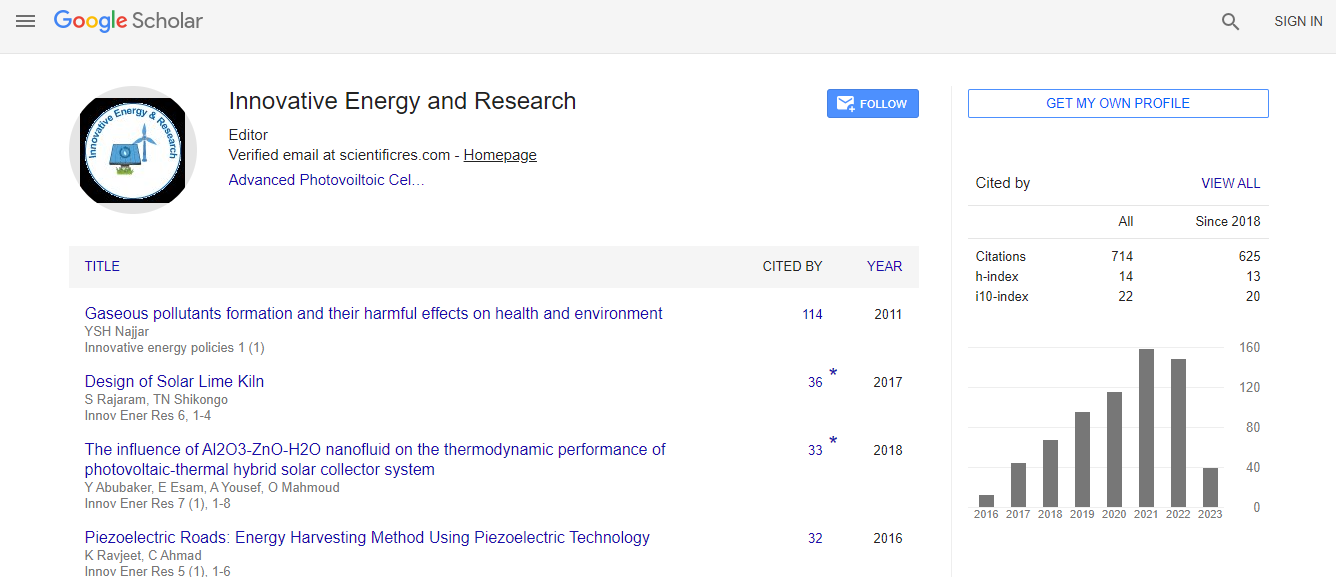Our Group organises 3000+ Global Conferenceseries Events every year across USA, Europe & Asia with support from 1000 more scientific Societies and Publishes 700+ Open Access Journals which contains over 50000 eminent personalities, reputed scientists as editorial board members.
Open Access Journals gaining more Readers and Citations
700 Journals and 15,000,000 Readers Each Journal is getting 25,000+ Readers
Google Scholar citation report
Citations : 712
Innovative Energy & Research received 712 citations as per Google Scholar report
Innovative Energy & Research peer review process verified at publons
Indexed In
- Google Scholar
- Open J Gate
- Genamics JournalSeek
- RefSeek
- Hamdard University
- EBSCO A-Z
- Publons
- Euro Pub
- ICMJE
Useful Links
Recommended Journals
Related Subjects
Share This Page
Polyacetylene: Myth, reality and a way forward
20th International Conference on Advanced Energy Materials and Research
Bruce S Hudson
Syracuse University, USA
ScientificTracks Abstracts: Innov Ener Res
Abstract
Polyacetylene, the simplest and oldest conducting polymer, has never been made in a form that permits rigorous determination of its structure. Trans polyacetylene will have two equivalent potential energy minima. It has been assumed that this results in bond length alternation. It is, however, very likely that the zero-point energy is above the Peierls barrier. Experimental studies that purport to show bond alternation have been reviewed and shown to be compromised by experimental inconsistencies or by the presence of finite chain polyenes. This situation has been reviewed in an open paper. A method for preparation of high molecular weight polyacetylene with fully extended chains that are prevented from reacting with neighboring chains by photochemical polymerization of a reactive guest molecule in urea inclusion complexes (UICs) is then discussed. The structural chemistry of these UIC materials will be reviewed. Our current projects involve guest species diiodo butadiene or diiodo hexatriene. The loss of iodine atoms during the elimination polymerization is monitored by weight loss. The polyacetylene chains form in UIC channels as fully extended chains that are parallel with a separation of 0.82 nm in a hexagonal lattice. The diene and triene guest species differ in crystal morphology with the triene presenting with hexagonal needles. Raman spectroscopy used to monitor the formation of polyene chains suffers loos of intensity when the chains are very long. The final material is characterized by vibrational inelastic neutron scattering using VISION at the Oak Ridge National Laboratory. Our ultimate objective is to measure electrical conduction of polyacetylene in urea inclusion compounds along the c-axis of the hexagonal channel. The strong bonding of carbons atoms suggests that this material may be a superconductor at room temperature due to the lack of thermally populated phonons. Methods for the formation of closed loop structures are being considered. Recent Publications: 1. Hudson B S and Allis D G (2013) Bond alternation in infinite periodic polyacetylene: dynamical treatment of the anharmonic potential. Journal of Molecular Structure 1032:78-82. 2. Dinca S A, Allis D G, Lashua A F, Sponsler M B and Hudson B S (2015) Insulated polyacetylene chains in an inclusion complex by photo polymerization. In Crystal Engineering - Design, New Materials and Application 1799:7-12. 3. Lashua A F, Smith T M, Hu H, Wei L, Allis D G, Sponsler M B and Hudson B S (2013) Commensurate urea inclusion crystals with the guest (e,e) 1,4-diiodo-1,3-butadiene. Crystal Growth & Design 13:3852-3855. 4. Marti Rujas J, Desmedt A, Harris K D M and Guillaume F (2009) Bidirectional transport of guest molecules through the nanoporous tunnel structure of a solid inclusion compound. Journal of Physical Chemistry A 113:736–743. 5. Hudson B S (2001) Oriented n-alkanes in urea-d4 inclusion complexes for inelastic neutron scattering vibrational studies. Molecular Crystals and Liquid Crystals 356:423-432.Biography
Bruce S Hudson received his Bachelor’s and Master’s degrees in Biophysical Chemistry from the California Institute of Technology in Pasadena, California and his PhD degree in Physical Chemistry from Harvard University where he worked for Bryan E Kohler on the peculiar electronic spectroscopy of linear conjugated polyenes. As part of his PhD thesis he proposed that the lowest excited electronic state of linear polyenes has the same symmetry as the ground electronic state involving doubly excited configurations. It is the merging of this excited state with the ground state for very long linear polyenes that gives rise to the double minimum potential of polyacetylene. He is a fellow of the American Physical Society.
E-mail: bshudson@syr.edu

 Spanish
Spanish  Chinese
Chinese  Russian
Russian  German
German  French
French  Japanese
Japanese  Portuguese
Portuguese  Hindi
Hindi 
